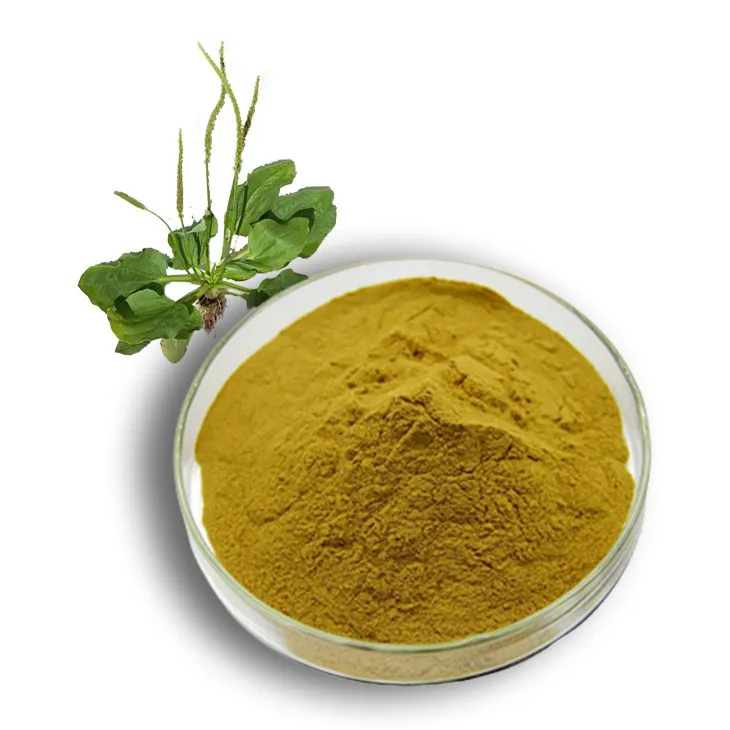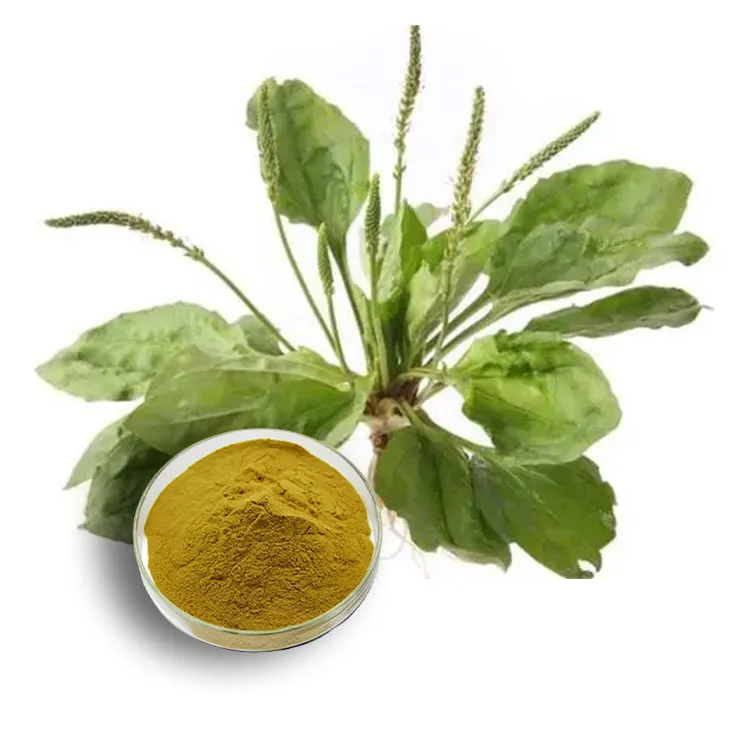- 0086-571-85302990
- sales@greenskybio.com
Plantain Extracts: Their Production Methods and Reasons for Their Popularity
2024-12-11

1. Introduction
Plantago asiatica, commonly known as Asian plantain, has been used in traditional medicine for centuries. The extract of this plant, Plantago asiatica extract, has gained significant popularity in recent years. This article aims to explore the production methods of this extract and the reasons behind its growing popularity.

2. Natural Origin of Plantago asiatica
2.1 Geographic Distribution
Plantago asiatica is native to Asia, particularly in regions such as China, Japan, and Korea. It can be found growing in a variety of habitats, including meadows, along roadsides, and in waste areas. The plant has adapted well to different environmental conditions, which has contributed to its widespread distribution.2.2 Botanical Features
The plant is an herbaceous perennial with broad, oval - shaped leaves that grow in a basal rosette. It has long, slender flower spikes that can reach up to 50 centimeters in height. The seeds are small and numerous, and they are contained within capsules. These botanical features play a role in the identification and collection of the plant for extraction purposes.
3. Production Methods of Plantago asiatica Extract
3.1 Harvesting
- The first step in the production of Plantago asiatica extract is the harvesting of the plant. The best time for harvesting is usually during the plant's flowering stage, when the active compounds are at their peak concentration.
- Harvesters need to carefully select healthy plants to ensure the quality of the extract. Only the above - ground parts of the plant, including the leaves and flower spikes, are typically harvested.
3.2 Drying
- After harvesting, the plant material needs to be dried. Drying can be done using natural methods, such as air - drying in a well - ventilated area, or by using artificial drying techniques like dehydrators.
- The drying process is crucial as it helps to preserve the active compounds in the plant. It also reduces the moisture content, preventing the growth of mold and bacteria during storage.
3.3 Extraction
- Once the plant material is dried, the extraction process can begin. There are several methods of extraction, including solvent extraction, supercritical fluid extraction, and maceration.
-
3.3.1 Solvent Extraction
- In solvent extraction, a suitable solvent such as ethanol or methanol is used to dissolve the active compounds from the dried plant material. The plant material is soaked in the solvent for a period of time, usually several hours to days.
- After soaking, the solvent containing the dissolved compounds is separated from the plant residue. This can be done through filtration or centrifugation.
- The solvent is then evaporated, leaving behind the concentrated extract. However, care must be taken during evaporation to avoid overheating, which could damage the active compounds.
-
3.3.2 Supercritical Fluid Extraction
- Supercritical fluid extraction uses a supercritical fluid, usually carbon dioxide, as the extraction solvent. The supercritical fluid has properties between those of a liquid and a gas, which allows it to penetrate the plant material more effectively.
- The plant material is placed in a high - pressure chamber with the supercritical fluid. The active compounds are dissolved in the supercritical fluid, and then the pressure is reduced to separate the fluid from the extract.
- This method is considered more environmentally friendly compared to solvent extraction as it uses a non - toxic and easily removable solvent. However, it requires specialized equipment and is more expensive.
-
3.3.3 Maceration
- Maceration is a simple and traditional extraction method. In this method, the dried plant material is soaked in a liquid, usually oil or water, for an extended period, often weeks or months.
- Over time, the active compounds are released into the liquid. The liquid is then separated from the plant material, and can be used directly as an extract or further processed to concentrate the active compounds.
3.4 Purification
- After extraction, the resulting extract may contain impurities. Purification steps are often necessary to obtain a high - quality extract.
- Techniques such as chromatography can be used to separate and purify the active compounds. This helps to remove any unwanted substances and ensure the purity and consistency of the extract.

4. Reasons for the Popularity of Plantago asiatica Extract
4.1 Medicinal Properties
- Antibacterial and Antifungal Activity: Plantago asiatica extract has been shown to possess antibacterial and antifungal properties. It can be used to treat various infections, both internally and externally. For example, it can be applied topically to treat skin infections caused by bacteria or fungi.
- Anti - inflammatory Effects: The extract has anti - inflammatory properties, which make it useful in the treatment of inflammatory conditions such as arthritis. It can help to reduce pain and swelling associated with these conditions.
- Digestive Health: Plantago asiatica extract can aid in digestive health. It has been used to treat digestive disorders such as diarrhea and constipation. It can also help to soothe the digestive tract and improve gut motility.
- Antioxidant Activity: The extract contains antioxidants that can protect the body against oxidative stress. Oxidative stress is associated with various diseases, including cancer and heart disease. By neutralizing free radicals, the extract can help to maintain overall health.
4.2 Cosmetic Applications
- Skin Care: In the field of cosmetics, Plantago asiatica extract is used in skin care products. It can help to moisturize the skin, improve skin elasticity, and reduce the appearance of wrinkles. It is also beneficial for treating acne - prone skin, as it has antibacterial properties.
- Hair Care: The extract can be used in hair care products as well. It can help to strengthen the hair follicles, promote hair growth, and prevent hair loss. It also has a conditioning effect on the hair, leaving it soft and shiny.
4.3 Nutritional Value
- The extract contains various nutrients such as vitamins, minerals, and dietary fiber. These nutrients can contribute to a healthy diet and overall well - being. For example, the presence of dietary fiber can aid in digestion and help to maintain a healthy weight.
4.4 Natural and Sustainable
- As a plant - based extract, Plantago asiatica extract is considered a natural alternative to synthetic ingredients. Consumers are increasingly interested in natural products, especially those that are sustainably sourced. The plant is relatively easy to cultivate and harvest, making it a sustainable source of extract.
5. Conclusion
Plantago asiatica extract has a rich history of use in traditional medicine and is now gaining popularity in various fields. Its production methods, which involve harvesting, drying, extraction, and purification, ensure the quality and effectiveness of the extract. The reasons for its popularity are diverse, including its medicinal properties, cosmetic applications, nutritional value, and natural and sustainable nature. As research on this extract continues, it is likely that its applications will expand further in the future.
FAQ:
What are the main production methods of Plantain extracts?
There are several common production methods for Plantain extracts. One method is solvent extraction. This involves using solvents like ethanol or water to extract the active compounds from the Plantago asiatica. The plant material is soaked in the solvent, and then through processes such as filtration and evaporation, the extract is obtained. Another method could be maceration, where the plant is gently crushed and left in a solvent for an extended period to allow the extraction of the desired components.
What are the active compounds in Plantain extracts?
Plantain Extracts contain various active compounds. Some of the important ones include polysaccharides, flavonoids, and phenolic acids. Polysaccharides contribute to its potential health - promoting properties such as immune modulation. Flavonoids are known for their antioxidant activities, which can help in protecting cells from oxidative damage. Phenolic acids also play a role in antioxidant and anti - inflammatory actions.
Why is Plantain Extracts popular in the skincare industry?
Plantain Extracts are popular in the skincare industry due to several reasons. Its antioxidant properties, mainly from the flavonoids and phenolic acids, help in fighting free radicals that can cause premature aging of the skin. It also has anti - inflammatory properties, which can be beneficial for treating skin conditions like acne, eczema, and psoriasis. Additionally, it can help in moisturizing the skin as it may enhance the skin's barrier function.
Are there any potential side effects of using Plantain Extracts?
Generally, when used in appropriate amounts, Plantain Extracts are considered safe. However, some people may be allergic to it, which can cause skin irritation, redness, or itching, especially when applied topically. Ingesting large amounts may also lead to some gastrointestinal discomfort in some individuals, but such cases are relatively rare.
How is the quality of Plantain Extracts ensured during production?
To ensure the quality of Plantain Extracts during production, several steps are taken. Firstly, the source of the Plantago asiatica is carefully selected to ensure that it is free from contaminants and pesticides. During the extraction process, strict quality control measures are implemented. This includes monitoring the extraction conditions such as temperature, time, and solvent concentration to ensure consistent and high - quality extraction. After extraction, the extract is often tested for purity, potency, and the presence of any harmful substances through techniques like chromatography and spectroscopy.
Related literature
- Production and Characterization of Plantago asiatica Extracts for Medicinal Applications"
- "The Popularity of Plantain Extracts in the Cosmetic Industry: A Review"
- "Optimization of Extraction Methods for Active Compounds in Plantain Extracts"
- ▶ Hesperidin
- ▶ citrus bioflavonoids
- ▶ plant extract
- ▶ lycopene
- ▶ Diosmin
- ▶ Grape seed extract
- ▶ Sea buckthorn Juice Powder
- ▶ Beetroot powder
- ▶ Hops Extract
- ▶ Artichoke Extract
- ▶ Reishi mushroom extract
- ▶ Astaxanthin
- ▶ Green Tea Extract
- ▶ Curcumin Extract
- ▶ Horse Chestnut Extract
- ▶ Other Problems
- ▶ Boswellia Serrata Extract
- ▶ Resveratrol Extract
- ▶ Marigold Extract
- ▶ Grape Leaf Extract
- ▶ blog3
- ▶ blog4
- ▶ blog5
-
Pure 85% Tomentil Extract.
2024-12-11
-
Fig Extract
2024-12-11
-
Black Garlic Extract
2024-12-11
-
Ginseng Root Extract
2024-12-11
-
Thunder God Vine Extract
2024-12-11
-
Marigold Extract
2024-12-11
-
Motherwort Extract
2024-12-11
-
Oat Straw Extract Powder
2024-12-11
-
Hericium erinaceus extract powder
2024-12-11
-
Red Wine Extract
2024-12-11
-
Stevia Extract
2024-12-11





















